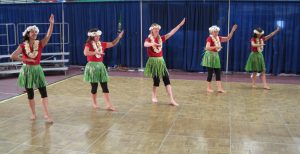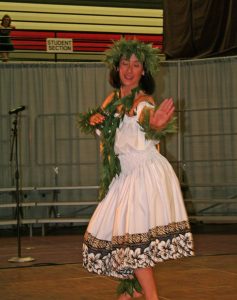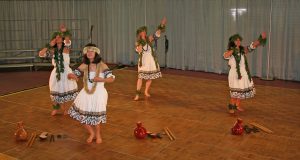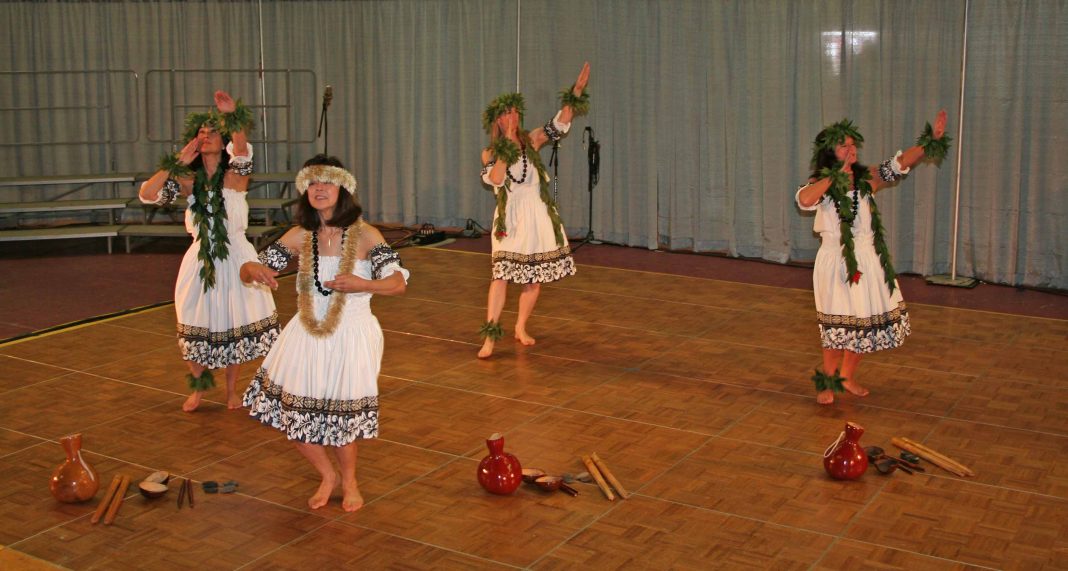Hula is an art. Once a week, the Na Pua Mai Kapili Aloha Dancers meet to practice that art. There are currently five members in the group—Reiko Callner, Cheryle Broom, Christy Raske, Judy Berg, and Claire Elliott—who each have a love and an appreciation for hula that extend back many years.
 “I love the culture that hula represents,” says Broom. “The music, the camaraderie of dancing together with a group that broadens your horizons, and the opportunity to share with the community.” Broom has been dancing with the group since she moved to Olympia in 1986. She was introduced to the group by a previous hula instructor, or kumu, with whom she danced in Seattle. Callner, who joined the group shortly after Broom, also expresses a love for “the cultural significance of the dance.”
“I love the culture that hula represents,” says Broom. “The music, the camaraderie of dancing together with a group that broadens your horizons, and the opportunity to share with the community.” Broom has been dancing with the group since she moved to Olympia in 1986. She was introduced to the group by a previous hula instructor, or kumu, with whom she danced in Seattle. Callner, who joined the group shortly after Broom, also expresses a love for “the cultural significance of the dance.”
Hula is a form of traditional Polynesian dance, usually performed to a chant or song, which tells a story. Dancers wear elaborate costumes and often utilize traditional implements in their performances. Some common implements include pu ili (split bamboo sticks), ipu (gourd drum), uli uli (feather coconut shell rattle), and ili ili (lava rocks used like castinettes), among others. These implements “are used both for their appearance and for the sounds that they make,” says Callner, “and are made originally from natural materials that are found on the Hawaiian Islands.” Dancers each have their own set of implements, which are personal to the individual. “You become very familiar with them,” says Callner, “Their feel is very natural to you. If you ever need to borrow another person’s implements, it’s a little strange in your hand, like riding somebody else’s horse.”

Callner became aware of hula while living in Hawaii in the late 1970s and early 1980s. “There was a halau (hula school) that would practice,” she says. “It was very interesting and inspiring, but I didn’t dance with them. When I moved to Washington, I got recruited by the (former leader) of this dance group, Vickie Era. I was happy to have the opportunity to learn hula after seeing it in Hawaii.”
Broom, similarly, has not always been a hula dancer. “I started because my mother lived in Hawaii for a while,” she says. While living in Seattle, Broom suggested to her mother that they get involved in hula together “and that’s where we met the women who became a kumu in Seattle,” who later introduced them to Era.
Raske and Berg, two other dancers, were also introduced to the group by Era. Raske joined in 1984, as one of the original members. “I started dancing in 1974 with another group in Olympia,” she says. She sought out a way to become involved in hula after it caught her attention when she was young. She has been dancing ever since, even attending workshops and “learning from kumus while visiting Hawaii.”
Berg joined in 1994, after she saw Era’s group perform. “I was very impressed with the dances and wished I was with that group,” says Berg, “Vickie invited me to visit and I have been with the group ever since.”

Elliott, the newest member, was introduced through Callner. Elliott grew up in Hawaii, and finds that performing hula helps her maintain a connection with the place she called home for her formative years.
These five women make up the current membership, although they have had “waves of participants in the past,” says Broom.
Despite their years of practice, “we are very much amateurs,” according to Callner. “Amateur means ‘for the love.’ We do it for the love of hula… this group is quite casual.” The casual nature of the group allows hula to be a creative outlet for these dancer, an escape from their professional lives. “You’ve got two auditors, a lawyer, and a college professor,” says Callner. “We’re all professional, and have serious jobs, so it’s a nice alternative endeavor.” One that is not only rewarding for its participants, but also “brings a great deal of joy and pleasure to the people we perform for.”
And they perform for many including “Northwest Folklife Festival in Seattle, Ethnic Celebration in Lacey, wedding celebrations, birthdays, retirement parties, the Rochester chicken races… ethnic and cultural events like the Japanese American Citizens League New Year’s Celebration. We were guest artists at the opening of the Longhouse at The Evergreen State College. We danced at Fort Lewis and in the State Capitol Rotunda. We danced for the Lakefair Princesses and in the Lakefair parade – and we danced at Judy’s 90th birthday,” according to Callner. And “luaus. Many luaus.” This is only a small selection of the events and celebrations at which the group has danced over the years.

“It makes people happy when we perform,” says Broom. She finds that people often feel transported. Some are reminded of past visits to the Hawaiian Islands, others are reminded of home. “I think we’ve contributed to our community in a positive, fun way,” she says. Callner also emphasizes the importance of community contribution. “I know, because people have told me and I can see it in their faces, that it… touches their hearts,” she says.
For the Na Pua Mai Kapili Aloha Dancers, and their audience, hula brings a bit of Hawaiian culture to Washington. To learn more, follow Na Pua Mai Kapili Aloha Dancers on Facebook.





















































